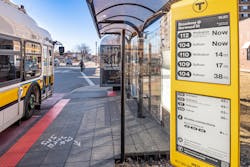The Massachusetts Bay Transit Authority (MBTA) is expanding the deployment of E Ink’s digital paper displays.
As part of the Green Line Transformation (GLT), MBTA initially added 10 solar-powered digital paper signs that display arrival times along the Green Line stations and recently expanded the deployment to include 18 additional signs at bus stops in six municipalities throughout greater Boston. Up-to-date arrival times and schedules are especially useful now, as weekday service has been reduced to support social distancing due to COVID-19.
The signs are designed to display real-time arrival information and service alerts, keeping riders up to date on when the next train or bus will arrive. The first stage of the pilot initially launched in 2017, when solar-powered signs were installed on the D branch of the Green Line. The first stage tested durability, performance and gathered customer feedback. With only 39 percent of the Green Line stations with the capability to provide real-time information, the pilot was designed to see if the gap could be closed with E Ink’s ePaper displays. Many stations have limited access to electricity or fiber communication lines, preventing the use of traditional displays that require a hard-wired installation. By using a combination of solar panels and E Ink’s low-power technology, these displays can be installed at any station, according to the company. The pilot was recently expanded to include additional bus stops, many of which lacked the infrastructure and connectivity to support standard real-time information displays.
“E Ink’s roots are in Boston, so we are proud to be a part of this project to sustainably keep passengers up-to-date with the most accurate information,” said Paul Apen, chief business and operations officer, E Ink. “In our rapidly changing environment, it’s important to provide passengers with the latest service information for the best possible experience.”
E Ink displays enable schedules and service alerts that can be displayed clearly and efficiently with the readability of paper. Unlike paper, this technology does not generate waste or require staff to manually update each location. The company says the displays are rugged and designed to withstand a large range of temperatures through summer and cold winters. Additionally, they are light-reflective rather than emissive, creating a sleek aesthetic and preventing the addition of light pollution to surrounding neighborhoods.



